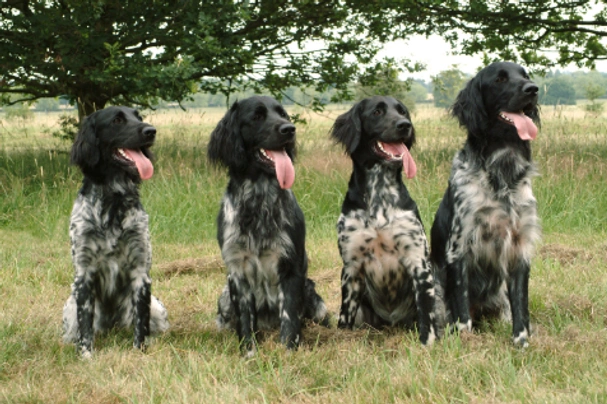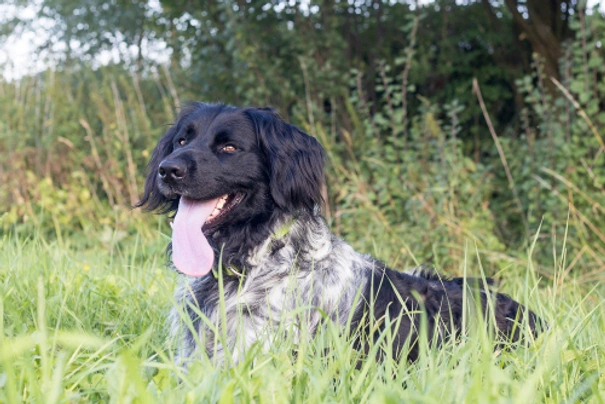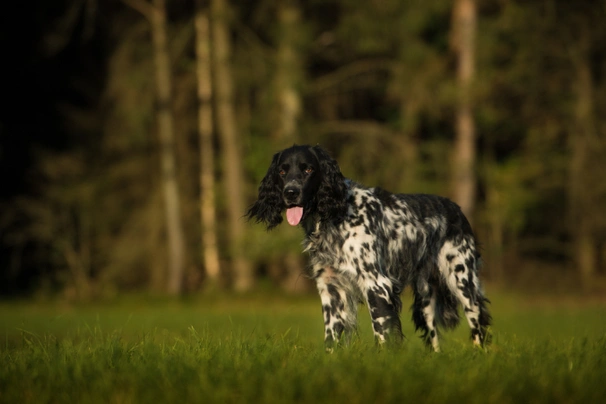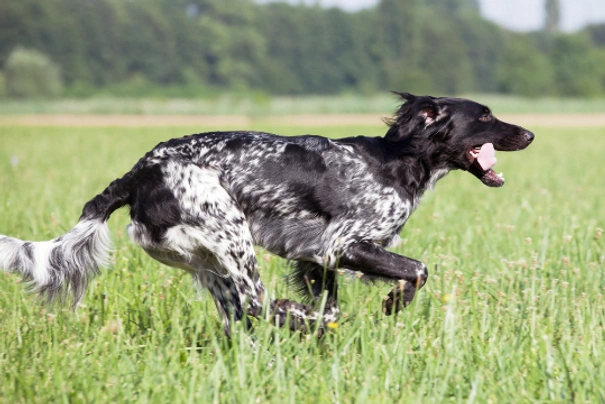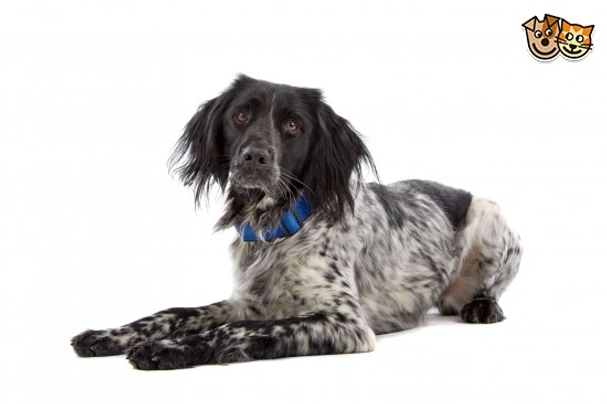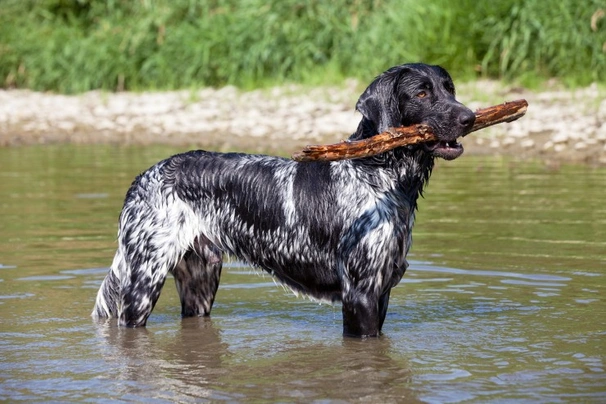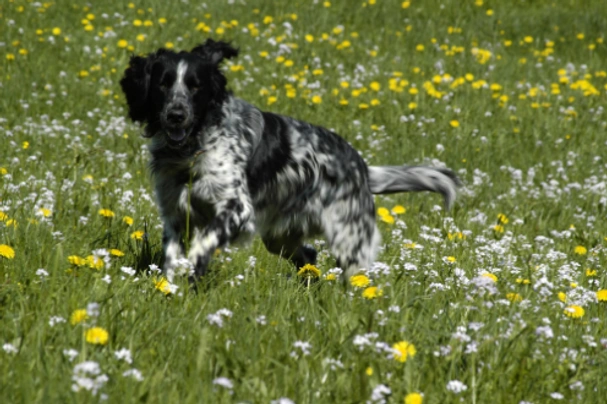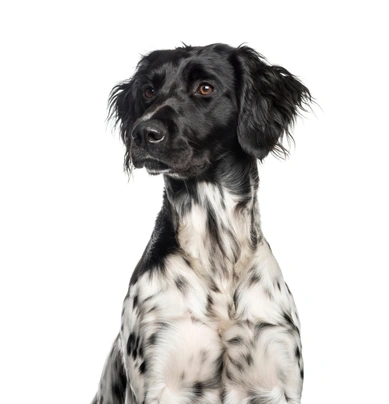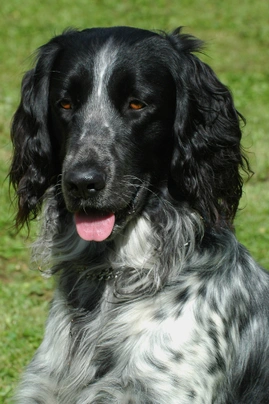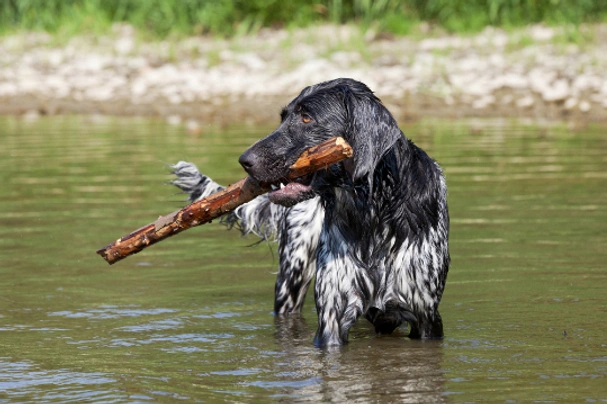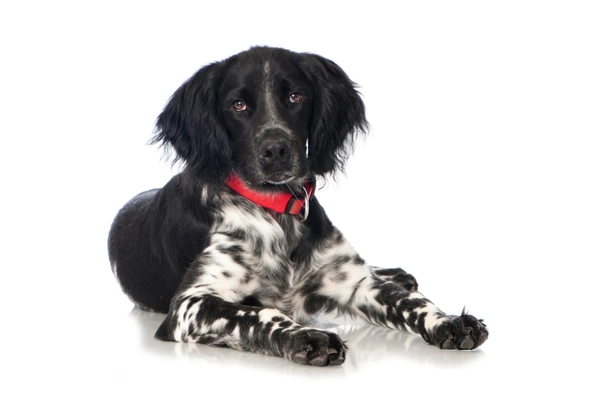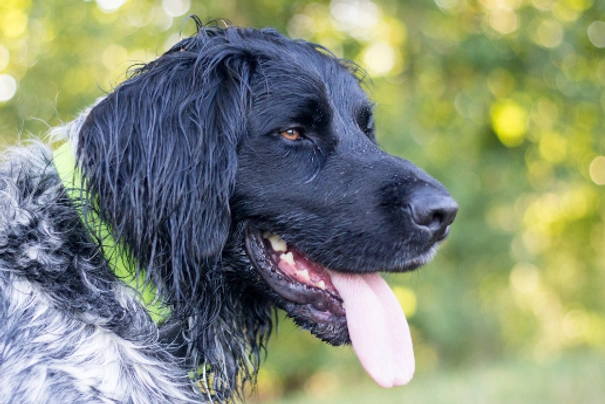Large Munsterlander
Pros
Cons
Introduction of the Large Munsterlander
The Large Munsterlander is not only a handsome and athletic looking dog that hails from Germany but they are loyal and affectionate characters that form strong bonds with their families and owners. Originally bred to work with hunters as gundogs they are also highly prized as companions and family pets in their native Germany.
Although Munsters are lesser known in the UK they are gaining popularity with people who lead active outdoor lives and who would like a loyal canine companion at their side and one that boasts a tremendous amount of stamina. The reason being that they are known to be trustworthy fun-loving companions and family pets. With this said anyone wanting to share a home with a Large Munsterlander would need to register their interest with breeders for the pleasure of doing so because few puppies are bred and registered with the Kennel Club every year.
History of the Large Munsterlander
The Large Munsterlander is native to Germany where they have always been highly prized gundogs. They were developed by breeding German Longhaired Pointers with liver and white coats. With this said very similar looking dogs have been found in artwork dating back to the Middle Ages and it's thought these dogs could well be the forefathers of the Munsterlander we see today.
At the time a standard was drawn up with the only acceptable colour being liver and white. As such any puppies with different colours were given away mainly to hunters and local German farmers. However as time passed puppies with black and white coats were also accepted as being true to type. However not long after this Munsterlanders with black and white coats could no longer be registered and it was not until 1919 that owners and breed enthusiasts formed a club calling their dogs Large Munsterlanders which separated them from other hunting dogs in Germany which included the Small Munsterlander.
The breed was first imported to the UK in the early seventies and two years later in 1973 The Large Munsterlander Club was established. The breed was also registered with the Kennel Club under “Rare Breeds”. In 1980 The Large Munsterlander was officially awarded Challenge Certificates and over the following years breed numbers have been slowly rising with more puppies being bred and registered with the Kennel Club every year. Large Munsterlanders are often seen out in the hunting field in the UK but they are still lesser known as family pets and companions. As such waiting lists can be long and Large Munsterlander puppies can often be expensive to buy.
Interesting facts about the breed
- Is the Large Munsterlander a vulnerable breed? No although the breed is quite rarely seen in the UK and as such waiting lists can be long and well-bred Kennel Club registered puppies can command a lot of money
- The Large Munsterlander has always been a highly prized gundog that boasts having a keen sense of smell
- Large Munsterlanders love being in and around water no matter what the weather
- Traditionally a Large Munsterlander’s tail was always docked but since the law banning the procedure came into effect in 2007 tail docking is now illegal with the exception being for some working breeds and if a dog suffers from some sort of health issue that requires their tails to be docked. The procedure must be agreed and authorised before being performed by a qualified vet failure to have the correct paperwork would result in heavy fines
Appearance of the Large Munsterlander
Height at the withers: Males 60 - 65 cm Females 58 - 63 cm
Average weight: Males 23 - 32 kg Females 23 - 32 kg
Large Munsterlanders are handsome well-proportioned and they have a lot of presence with their striking coats and proud looks. They are always alert and ready to be involved in what is going on around them whether in the field or in a home environment. Their heads are nicely in proportion to the rest of their body with dogs having slightly domed skulls without a pronounced occiput or stop. They have strong jaws and well-developed black noses with wide nostrils and well fitting slightly rounded lips.
The Large Munster has medium sized dark brown eyes with dogs always having an intelligent affectionate look about them. Their ears are set high being broad with rounded tips and they lie close to a dog's head. They have a strong jaw with a perfect scissor bite where their upper teeth neatly overlap their lower ones. Necks are muscular and strong being slightly arched and merging smoothly into a dog's shoulders. Chests are wide with dogs having a nice depth to their brisket. Their shoulders are well laid back and front legs are straight well-muscled and strong.
The Large Munsterlander has a strong and powerful body with a firm level back that is slightly higher at the withers before it slopes smoothly to the croup and tail. Loins are muscular wide with dogs having well sprung deep ribs that reach up to the loin. Bellies are slightly tucked up which adds to the Large Munster's athletic appearance. Hips are broad with dogs having well-muscled back legs and their feet are tight well-padded being slightly round in shaped being well knuckled with a lot of thick hair between the toes. Tails are well feathered and set high being in line with a dog's back and thicker at the root before it tapers to the tip. Dogs carry their tails horizontally or slightly curved.
When it comes to their coat the Large Munsterlander boasts having a long dense coat and lots of feathering on their front and back legs as well as on their tails. Males have more feathering than their female counterparts. The hair on a dog's head lies flat being shorter and smoother. The accepted breed colour for Kennel Club registration are as follows:
- Black & Blue Roan
- Black & White
- White & Black
It is worth noting that the accepted breed colours for Kennel Club registration can differ from those set out in the breed standard which are as follows:
- A dog’s head is solid black with a white blaze and star or snip. Bodies are white or blue roan with dog’s having black patches which can be ticked flecked or a combination of the two
Gait/movement
When a Large Munsterland moves they do so taking long free and springy strides covering a lot of ground when they do.
Faults
The Kennel Club frowns on any exaggerations or departures from the breed standard and would judge the faults on how much they affect a dog's overall health and wellbeing as well as their ability to perform.
Males should have both testicles fully descended into their scrotums and it is worth noting that a dog can be a little lighter or heavier as well as slightly taller or shorter than set out in the Kennel Club breed standard which is only given as a guideline.
Temperament of the Large Munsterlander
The Large Munsterlander is a reliable very loyal and affectionate dog that for many years has been highly prized by hunters thanks to their intelligence and their desire to get a job done. They are very social dogs by nature which makes them extremely adaptable and which is just one of the reasons why they make such great family pets. With this said they can be vocal at times and are quick to let their owners know when they are any strangers about making them good watchdogs.
They form very strong bonds with their owners and like nothing more than to greet them on their return to the home by offering presents a very endearing trait they are known to have. However they do not like to be left on their own for long periods of time which means they are best suited to people who work from home and in households where at least one person usually stays at home when everyone else is out of the house so they always have company.
They are a good choice for first time owners because the Large Munster is easy to train and picks new things up very quickly. However anyone wishing to share a home with one of these handsome dogs would need to have the time to dedicate to their canine companion when it comes to the amount of exercise they need to be truly happy well-rounded dogs.
It's important for puppies to be well socialised from a young age and this has to include introducing them to lots of new situation noises people other animals and dogs once they have been fully vaccinated so they grow up to be well-rounded and obedient dogs no matter where they are taken. They love being in and around water which means care has to be taken when walking a Large Munster off their leads anywhere near more dangerous water courses just in case a dog decides to leap in.
It's important for Large Munsterlanders to be taught their place in the pack and who is alpha dog in a household or they might start to show the more dominant side of their nature which can lead to dogs being wilful and unruly therefore harder to handle and live with.
Are they a good choice for first time owners?
Large Munsterlanders are not the best choice for first time dog owners because they must he socialised handled and trained by people who are familiar with the needs of such an intelligent and active canine companion that has retained a strong sense to hunt/point and retrieve even in a home environment.
What about prey drive?
Having been bred to hunt which is a trait that is deeply embedded in their psyche Munsters have a high prey drive and will happily go off after any smaller animal they spot. As such care should always be taken as to where and when a Munster can run off the lead more especially if there is livestock and/or wildlife close by. The good news is that because Munsters are so intelligent and eager to please they can be trained to respond well to the recall command.
What about playfulness?
Munsters have a very playful side to their natures and love to entertain and be entertained. They are known to be a little mischievous when the mood takes them and being so clever they quickly learn how to please an owner and how to get their own way.
What about adaptability?
Munsters are better suited to people who lead active outdoor lives and who have secure well-fenced back gardens a dog can safely roam in whenever possible to really let off steam. They would not be happy living in an apartment in town which could see them developing some destructive and unwanted behavioural issues.
What about separation anxiety?
Munsters form strong ties with their families and dogs are never very happy when they find themselves left on their own for longer periods of time. They are better suited to people who either work from home or in households where one person stays at home when everyone else is out so they are never alone for any length of time which could see a dog suffering from separation anxiety. This can lead to them being destructive around the home which is a dog's way of relieving any stress they are feeling and a way to keep themselves entertained.
What about excessive barking?
Some Munsters like the sound of their own voices a little too much which is something that needs to be gently nipped in the bud when a dog is still young being careful not to frighten them. Others will only bark when there are strangers about or when something they don't like is going on in their surroundings. With this said if left to their own devices for longer periods of time all dogs including Munsters would bark to get someone’s attention.
Do Large Munsterlanders like water?
Large Munsterlanders love being in and around water no matter what the weather. However if anyone who owns a dog that does not like water should never force them to go in because it would just end up scaring them. With this said care should always be taken when walking a Munster off the lead anywhere near more dangerous watercourses just in case a dog decides to leap in and then needs rescuing because they cannot get out of the water on their own.
Are Large Munsterlanders good watchdogs?
Munsters are not natural watchdogs although this is not to say a dog would not be quick off the mark to let an owner know when there are strangers about although they would rarely do this aggressively preferring to keep their distance stand their ground and bark.
Intelligence / Trainability of the Large Munsterlander
The Large Munsterlander is a highly intelligent dog and one that likes nothing better than to please. They pick things up very quickly but the downside to this is that they are just as fast to pick up some bad habits and behaviours too. As such their training has to start early and it has to be consistent and always fair so that dogs understand what is expected of them.
The key to successfully training one of these smart dogs is to make their training sessions as interesting as possible and to indulge a dog's strong desire to retrieve things rather than to try to prevent them from doing what they have always been bred to do. Shorter training sessions will help keep a dog more focussed on what is being asked of them too. They are quite sensitive by nature and as such they do not respond well to any sort of harsh correction or heavier handed training methods. They do however answer very well to positive reinforcement which always brings the best out of these intelligent high energy dogs.
Like all puppies Munsters are incredibly cute when young and it is all too easy to spoil them when they first arrive in new homes. However owners must start out as they mean to go on by laying down ground rules and boundaries so that a puppy understands what is expected of them. It also helps establish a “pecking order” and who the alpha dog is in a household. The first commands a puppy should be taught are as follows:
- Come
- Sit
- Stay
- Heel
- Quiet
- Leave it
- Down
- Bed
Children and other
The Large Munsterlander thrives in a home environment and enjoys being involved in everything that goes on in a household which includes playing games with the kids. They seem to have a natural affinity with children and are always extra gentle when they are around them. However any interaction between toddlers and a dog should always be well supervised by an adult to make sure playtime does not get too boisterous which could end up with a child being knocked over albeit by accident.
They are known to get on well with other dogs and pets more especially if they have been well socialised from a young enough age. If they have grown up with a family cat in a household they usually get on well together but they might chase off any other cats they meet. It’s always best to be careful when a dog is around any other small animals and pets just in case.
Health of the Large Munsterlander
The average life expectancy of a Large Munsterlander is between 11 and 13 years when properly cared for and fed an appropriate good quality diet to suit their ages.
The Large Munster is known to suffer from a few hereditary health issues which are worth knowing about if you are planning share your home with one of these active and handsome dogs. The conditions that seem to affect the breed the most include the following:
- Hereditary cataracts - breeders should have stud dog eye tested
- Hip dysplasia - breeders should have stud dogs hip scored (mean score 8.5 – parents must be lower)
- Hyperuricosuria HUU (urinary stones) - breeders should have stud dogs tested
- Hereditary cataracts – dogs must be eye tested
- Osteochondrosis of the shoulders – mainly male dogs
- Black hair follicular dysplasia
It is worth noting that the breed COI with the Kennel Club currently stands at 7.7%.
What about vaccinations?
Munster puppies would have been given their initial vaccinations before being sold but it is up to their new owners to make sure they have their follow-up shots in a timely manner with the vaccination schedule for puppies being as follows:
- 10 -12 weeks old bearing in mind that a puppy would not have full protection straight away but would be fully protected 2 weeks after they have had their second vaccination
There has been a lot of discussion about the need for dogs to have boosters. As such it's best to talk to a vet before making a final decision on whether a dog should continue to have annual vaccinations which are known as boosters.
What about spaying and neutering?
A lot of vets these days recommend waiting until dogs are slightly older before spaying and neutering them which means they are more mature before undergoing the procedures. As such they advise neutering males and spaying females when they are between the ages of 6 to 9 months old and sometimes even when a dog is 12 months old.
Other vets recommend spaying and neutering dogs when they are 6 months old but never any earlier unless for medical reasons. With this said many breeds are different and it is always advisable to discuss things with a vet and then follow their advice on when a dog should be spayed or neutered.
What about obesity problems?
As with other breeds some Munsters gain weight after they have been spayed or neutered and it's important to keep an eye on a dog's waistline just in case they do. If a dog starts to put on weight it's important to adjust their daily calorie intake and to up the amount of exercise they are given. Older dogs too are more prone to gaining weight and again it's essential they be fed and exercised accordingly because obesity can shorten a dog's life by several years. The reason being that it puts a lot of extra strain on a dog's internal organs including the heart which could prove fatal**.**
What about allergies?
Munsters are predisposed to suffering from black hair follicular dysplasia and sometimes allergy flare ups so it's important for a dog to see a vet sooner rather than later when it happens. Allergies can be notoriously hard to clear up and finding the triggers can be challenging. With this said a vet would be able to make a dog with an allergy more comfortable while they try to find out the triggers which could include the following:
- Certain dog foods that contain high levels of grains and other cereal-type fillers
- Airborne pollens
- Dust mites
- Environment
- Flea and tick bites
- Chemicals found in everyday household cleaning products
Participating in health schemes
All responsible Large Munsterlander breeders would ensure that their stud dogs are tested for known hereditary and congenital health issues known to affect the breed by using the following schemes:
What about breed specific breeding restrictions?
Apart from the standard breeding restrictions that are in place for all Kennel Club registered breeds there are no other breed specific breeding restrictions in place for the Large Munsterlander.
What about Assured Breeder Requirements?
It is mandatory for Kennel Club Assured breeders to use the following tests on their dogs and all other breeders are strong advised to follow suit:
The Kennel Club also highly recommends that all breeders use the following test on dogs:
Caring for the Large Munsterlander
As with any other breed Large Munsters need to be groomed on a regular basis to make sure their coats and skin are kept in top condition. They also need to be given regular daily exercise to ensure they remain fit and healthy. On top of this dogs need to be fed good quality food that meets all their nutritional needs throughout their lives.
Caring for a Large Munsterlander puppy
Munster puppies are boisterous and full of life which means it's essential for homes and gardens to be puppy-proofed well in advance of their arrival. A responsible breeder would have well socialised their puppies which always leads to more outgoing confident and friendly dogs right from the word go. With this said any puppy is going to feel vulnerable when they leave their mother and littermates which must be taken into account. The longer a puppy can remain with their mother the better although it should never be for too long either.
It's best to pick a puppy up when people are going to be around for the first week or so which is the time needed for a puppy to settle in. Puppy-proofing the home and garden means putting away any tools and other implements that a boisterous puppy might injure themselves on. Electric wires and cables must be put out of their reach because puppies love chewing on things. Toxic plants should be removed from flowerbeds and the home too.
Puppies need to sleep a lot to grow and develop as they should which means setting up a quiet area that's not too out of the way means they can retreat to it when they want to nap and it's important not to disturb them when they are sleeping. It's also a good idea to keep "playtime" nice and calm inside the house and to have a more active "playtime" outside in the garden which means puppies quickly learn to be less boisterous when they are inside.
The documentation a breeder provides for a puppy must have all the details of their worming date and the product used as well as the information relating to their microchip. It is essential for puppies to be wormed again keeping to a schedule which is as follows:
- Puppies should be wormed at 6 months old
- They need to be wormed again when they are 8 months old
- Puppies should be wormed when they are 10 months old
- They need to be wormed when they are 12 months old
Things you'll need for your puppy
There are certain items that new owners need to already have in the home prior to bringing a new puppy home. It's often a good idea to restrict how much space a puppy plays in more especially when you can't keep an eye on what they get up to bearing in mind that puppies are often quite boisterous which means investing in puppy gates or a large enough playpen that allows a puppy the room to express themselves while keeping them safe too. The items needed are therefore as follows:
- Good quality puppy or baby gates to fit on doors
- A good well-made playpen that's large enough for a puppy to play in so they can really express themselves as puppies like to do
- Lots of well-made toys which must include good quality chews suitable for puppies to gnaw on bearing in mind that a puppy will start teething anything from when they are 3 to 8 months old
- Good quality feed and water bowls which ideally should be ceramic rather than plastic or metal
- A grooming glove
- A slicker brush or soft bristle brush
- Dog specific toothpaste and a toothbrush
- Scissors with rounded ends
- Nail clippers
- Puppy shampoo and conditioner which must be specifically formulated for use on dogs
- A well-made dog collar or harness
- A couple of strong dog leads
- A well-made dog bed that's not too small or too big
- A well-made dog crate for use in the car and in the home that's large enough for a puppy to move around in
- Baby blankets to put in your puppy's crate and in their beds for when they want to nap or go to sleep at night
Keeping the noise down
All puppies are sensitive to noise including Large Munsterlander puppies. It's important to keep the noise levels down when a new puppy arrives in the home. TVs and music should not be played too loud which could end up stressing a small puppy out making them withdrawn timid and shy.
Keeping vet appointments
As previously mentioned Munster puppies would have been given their first vaccinations by the breeders but they must have their follow up shots which is up to their new owners to organise. The vaccination schedule for puppies is as follows:
- 10 -12 weeks old bearing in mind that a puppy would not have full protection straight away but would only be fully protected 2 weeks after they have had their second vaccination
When it comes to boosters it's best to discuss these with a vet because there is a lot of debate about whether a dog really needs them after a certain time. However if a dog ever needed to go into kennels their vaccinations would need to be fully up to date.
What about older Large Munsterlander when they reach their senior years?
Older Munsters need lots of special care because as they reach their golden years they are more at risk of developing certain health concerns. Physically a dog's muzzle may start to go grey but there will be other noticeable changes too which includes the following:
- Coats become coarser
- A loss of muscle tone
- They can either become overweight or underweight
- They have reduced strength and stamina
- Older dogs have difficulty regulating their body temperature
- They often develop arthritis
- Immune systems do not work as efficiently as they once did which means dogs are more susceptible to infections
- Older dogs change mentally too which means their response time tends to be slower as such they develop the following:
- They respond less to external stimuli due to impaired vision or hearing
- They tend to be a little pickier about their food
- They have a lower pain threshold
- Become intolerant of any change
- Often an older dog can feel disorientated
Living with a Large Munsterlander in their golden years means taking on a few more responsibilities but these are easily managed and should include looking at their diet the amount of exercise they are given how often their dog beds need changing and keeping an eye on the condition of their teeth.
Older Munsters need to be fed a good quality diet that meets their needs at this stage of their lives all the while keeping a close eye on a dog's weight. A rough feeding guide for older dogs is as follows bearing in mind they should be fed highly digestible food that does not contain any additives:
- Protein content should be anything from 14 – 21%
- Fat content should be less than 10%
- Fibre content should be less than 4%
- Calcium content should be 0.5 – 0.8%
- Phosphorous content should be 0.4 – 0.7%
- Sodium content should be 0.2 – 0.4%
Older Munsters don't need to be given the same amount of daily exercise as a younger dog but they still need the right amount of physical activity to maintain muscle tone and to prevent a dog from putting on too much weight. All dogs need access to fresh clean water and this is especially true of older dogs when they reach their golden years because they are more at risk of developing kidney disorders.
Grooming of the Large Munsterlander
The Large Munsterlander boasts having a short to medium length coat and as such they are low maintenance in the grooming department. They need to be brushed once or twice a week to keep things tidy and to remove any dead from their coats and to prevent any tangles or knots forming in the feathers on their legs and tails. Any excessively long hair that grows between a dog's toes needs to be trimmed as does the feathering on their legs if it gets too long.
It's also important to check a dog's ears on a regular basis and to clean them when necessary. If too much wax is allowed to build up in a dog's ears it can lead to a painful infection which can be hard to clear up. In short prevention is often easier than cure when it comes to ear infections.
Exercise of the Large Munsterlander
The Large Munsterlander is a high energy intelligent dog and as such they need to be given the right amount of daily exercise and mental stimulation for them to be truly happy well-rounded dogs. They need to be given at least 2 hour's exercise a day with as much off the lead time as possible. If they are not given the right amount of mental stimulation and exercise every day a Large Munster would quickly get bored and could even begin to show some destructive behaviours around the home which is their way of relieving the stress they are feeling.
A shorter walk in the morning would be fine but a longer more interesting one in the afternoon is a must. These dogs also like to be able to roam around a back garden as often as possible so they can really let off steam. However the fencing has to be extremely secure to keep these active dogs in because if they find a weakness in the fence they will soon escape out and get into all sorts of trouble.
With this said puppies should not be over exercised because their joints and bones are still growing. This includes not letting a dog jump up and down from furniture or going up or down the stairs. Too much pressure placed on their joints and spines at an early age could result in a dog developing serious problems later in their lives.
Feeding of the Large Munsterlander
If you get a Large Munsterlander puppy from a breeder they would give you a feeding schedule and it's important to stick to the same routine feeding the same puppy food to avoid any tummy upsets. You can change a puppy's diet but this needs to be done very gradually always making sure they don't develop any digestive upsets and if they do it's best to put them back on their original diet and to discuss things with the vet before attempting to change it again.
Older dogs are not known to be fussy eaters but this does not mean they can be fed a lower quality diet. It's best to feed a mature dog twice a day once in the morning and then again in the evening making sure it's good quality food that meets all their nutritional requirements. It's also important that dogs be given the right amount of exercise so they burn off any excess calories or they might gain too much weight which can lead to all sorts of health issues. Obesity can shorten a dog's life by several years so it's important to keep an eye on their waistline from the word go.
Feeding guide for a Large Munsterlander puppy
Puppies need to be fed a highly nutritious good quality diet for them to develop and grow as they should. As a rough guide a Munster puppy can be fed the following amounts every day making sure their meals are evenly spread out throughout the day and it's best to feed them 3 or 4 times a day:
- 2 months old - 262g to 307g depending on puppy's build
- 3 months old - 332g to 403g depending on puppy's build
- 4 months old - 362g to 445g depending on puppy's build
- 5 months old - 401g to 527g depending on puppy's build
- 6 months old - 438g to 599g depending on puppy's build
- 7 months old - 438g to 600g depending on puppy's build
- 8 months old - 407g to 596g depending on puppy's build
- 9 months old - 379g to 556g depending on puppy's build
- 10 months old - 344g to 520g depending on puppy's build
- 11 months old - 311g to 475g depending on puppy's build
- 12 months old - 309g to 433g depending on puppy's build
- 13 months old - 306g to 430g depending on puppy's build
- 14 months old - 306g to 420g depending on puppy's build
Once a puppy is 15 months old they can be fed adult dog food.
Feeding guide for an adult Large Munsterlander
Once fully mature an adult Large Munsterlander should be fed a good quality diet to ensure their continued good health. As a rough guide an adult dog can be fed the following amounts every day:
- Dogs weighing 23 kg can be fed 292g to 382g depending on activity
- Dogs weighing 25 kg can be fed 307g to 409g depending on activity
- Dogs weighing 32 kg can be fed 322g to 424g depending on activity
Large Munsterlander price
If you are looking to buy a Large Munsterlander you would need to register your interest with breeders and agree to being put on a waiting list because very few puppies are bred and registered with The Kennel Club every year. You would need to pay anything upwards of £500 for a well-bred pedigree puppy.
The cost of insuring a male 3-year-old Large Munsterlander in northern England would be £29.54 a month for basic cover but for a lifetime policy this would set you back £64.71 a month (quote as of October 2018). When insurance companies calculate a pet's premium they factor in several things which includes where you live in the UK a dog's age and whether they have been neutered or spayed among other things.
When it comes to food costs you need to buy the best quality food whether wet or dry making sure it suits the different stages of a dog’s life. This would set you back between £40 - £50 a month. On top of this you need to factor in veterinary costs if you want to share your home with a Large Munsterlander and this includes their initial vaccinations their annual boosters the cost of neutering or spaying a dog when the time is right and their yearly health checks all of which quickly adds up to over £1100 a year.
As a rough guide the average cost to keep and care for a Large Munsterlander would be between £80 to £120 a month depending on the level of insurance cover you opt to buy for your dog but this does not include the initial cost of buying a well-bred healthy Kennel Club registered pedigree Large Munsterlander puppy.
Buying advice
When visiting and buying any puppy or dog there are many important things to consider and questions to ask of the breeder/seller. You can read our generic puppy/dog advice here which includes making sure you see the puppy with its mother and to verify that the dog has been wormed and microchipped.
Munsters are quite a rarely seen in the UK with few puppies being registered with the Kennel Club every year which means they can often command a lot of money. As such with Large Munsterlanders there is specific advice questions and protocols to follow when buying a puppy which are as follows:
- Prospective owners may find online and other adverts showing images of adorable Munster puppies for sale. However the sellers ask buyers for money up front before agreeing to deliver a puppy to a new home. Potential buyers should never buy a Large Munsterlander puppy unseen and should never pay a deposit to a seller before collecting a puppy from them
- As previously touched upon finding Large Munsterlander puppies can be difficult and waiting lists tend to be long. As such some amateur breeders/people breed from a dam far too often so they can make a quick profit without caring for the welfare of the puppies their dam or the breed in general. Under Kennel Club rules a dam can only produce 4 litters and she must be between a certain age to do so. Anyone wishing to buy a puppy should think very carefully about who they purchase their puppy from and should always ask to see the relevant paperwork pertaining to a puppy's lineage their vaccinations and their microchipping
- Traditionally a Large Munsterlander’s tail was always docked but since the law banning the procedure came into effect in 2007 tail docking is now illegal with the exception being for some working breeds and if a dog suffers from some sort of health issue that requires their tails to be docked. The procedure must be agreed and authorised before being performed by a qualified vet failure to have the correct paperwork would result in heavy fines

